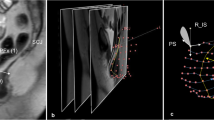Abstract
Introduction and hypothesis
Two-dimensional magnetic resonance imaging (MRI) demonstrates apical support and vaginal length contribute to anterior wall prolapse (AWP). This paper describes a novel three-dimensional technique to examine the vagina and its relationship to pelvic sidewalls at rest and Valsalva.
Methods
Twenty women (10 with AWP and 10 with normal support) underwent pelvic magnetic resonance imaging at rest and Valsalva. Three-dimensional reconstructions of the pelvic bones and anterior vaginal wall were created to assess morphologic changes occurring in prolapse.
Results
In women with AWP, Valsalva caused downward translation of the vagina along its length. A transition point separated a proximal region supported by levator muscles and a distal, unsupported region no longer in contact with the perineal body. In this latter region, sagittal and frontal plane “cupping” occurs. The distal vagina rotated inferiorly along an arc centered on the inferior pubis.
Conclusion
Downward translation, cupping, and distal rotation are three novel characteristics of AWP demonstrated by this three-dimensional technique.





Similar content being viewed by others
References
Olsen AL, Smith VJ, Bergstrom JO, Colling JC, Clark AL (1997) Epidemiology of surgically managed pelvic organ prolapse and urinary incontinence. Obstet Gynecol 89(4):501–506
Jelovsek JE, Maher C, Barber MD (2007) Pelvic organ prolapse. Lancet 369(9566):1027–1038
He W, Sengupta M, Velkoff V, DeBarros K (2005) 65± in the US: 2005, current population report, special studies. United States Government Printing Office, Washington DC. December 2005. Available from: www.census.gov
Benson JT, Lucente V, McClellan E (1996) Vaginal versus abdominal reconstructive surgery for the treatment of pelvic support defects: a prospective randomized study with long-term outcome evaluation. Am J Obstet Gynecol 175(6):1418–1421, discussion 1421–1422
Nguyen JN, Burchette RJ (2008) Outcome after anterior vaginal prolapse repair: a randomized controlled trial. Obstet Gynecol 111(4):891–898
Nguyen JK (2001) Current concepts in the diagnosis and surgical repair of anterior vaginal prolapse due to paravaginal defects. Obstet Gynecol Surv 56(4):239–246
Maher C, Baessler K (2006) Surgical management of anterior vaginal wall prolapse: an evidencebased literature review. Int Urogynecol J Pelvic Floor Dysfunct 17(2):195–201
Maher CF, Murray CJ, Carey MP, Dwyer PL, Ugoni AM (2001) Iliococcygeus or sacrospinous fixation for vaginal vault prolapse. Obstet Gynecol 98(1):40–44
Shull BL, Bachofen C, Coates KW, Kuehl TJ (2000) A transvaginal approach to repair of apical and other associated sites of pelvic organ prolapse with uterosacral ligaments. Am J Obstet Gynecol 183(6):1365–1373, discussion 1373–1374
Hsu Y, Chen L, Summers A, Ashton-Miller JA, DeLancey JO (2008) Anterior vaginal wall length and degree of anterior compartment prolapse seen on dynamic MRI. Int Urogynecol J Pelvic Floor Dysfunct 19(1):137–142
Rooney K, Kenton K, Mueller ER, FitzGerald MP, Brubaker L (2006) Advanced anterior vaginal wall prolapse is highly correlated with apical prolapse. Am J Obstet Gynecol 195(6):1837–1840
Summers A, Winkel LA, Hussain HK, DeLancey JO (2006) The relationship between anterior and apical compartment support. Am J Obstet Gynecol 194(5):1438–1443
Delancey JO (2002) Fascial and muscular abnormalities in women with urethral hypermobility and anterior vaginal wall prolapse. Am J Obstet Gynecol 187(1):93–98
Larson KA, Hsu Y, DeLancey JO (2009) The relationship between superior attachment points for anterior wall mesh operations and the upper vagina using a 3-dimensional magnetic resonance model in women with normal support. Am J Obstet Gynecol 200(5):554.e1–554.e6
Chen L, Ashton-Miller JA, Hsu Y, DeLancey JO (2006) Interaction among apical support, levator ani impairment, and anterior vaginal wall prolapse. Obstet Gynecol 108(2):324–332
Chen L, Ashton-Miller JA, Delancey JO (2009) A 3D finite element model of anterior vaginal wall support to evaluate mechanisms underlying cystocele formation. J Biomech 42:1371–1277
Bertschinger KM, Hetzer FH, Roos JE, Treiber K, Marincek B, Hilfiker PR (2002) Dynamic MR imaging of the pelvic floor performed with patient sitting in an open-magnet unit versus with patient supine in a closed-magnet unit. Radiology 223(2):501–508
Fielding JR, Griffiths DJ, Versi E, Mulkern RV, Lee ML, Jolesz FA (1998) MR imaging of pelvic floor continence mechanisms in the supine and sitting positions. AJR Am J Roentgenol 171(6):1607–1610
Barber MD, Brubaker L, Nygaard I, Wheeler TL 2nd, Schaffer J, Chen Z, Spino C (2009) Defining success after surgery for pelvic organ prolapse. Obstet Gynecol 114(3):600–609
Trowbridge ER, Fultz NH, Patel DA, DeLancey JO, Fenner DE (2008) Distribution of pelvic organ support measures in a population-based sample of middle-aged, community-dwelling African American and white women in southeastern Michigan. Am J Obstet Gynecol 198(5):548.e1-6
Swift S, Woodman P, O'Boyle A, Kahn M, Valley M, Bland D, Wang W, Schaffer J (2005) Pelvic Organ Support Study (POSST): the distribution, clinical definition, and epidemiologic condition of pelvic organ support defects. Am J Obstet Gynecol 192(3):795–806
Acknowledgements
We gratefully acknowledge support from the National Institute of Child Health and Human Development Grants R01 HD 38665 with additional investigator support from the Office for Research on Women’s Health SCOR on Sex and Gender Factors Affecting Women’s Health 1 P50 HD044406.
Conflicts of interest
Dr. John OL DeLancey and Dr. James Ashton-Miller are consultants to American Medical Systems and Johnson and Johnson Personal Products. The other authors have no disclosures to report.
Author information
Authors and Affiliations
Corresponding author
Rights and permissions
About this article
Cite this article
Larson, K.A., Hsu, Y., Chen, L. et al. Magnetic resonance imaging-based three-dimensional model of anterior vaginal wall position at rest and maximal strain in women with and without prolapse. Int Urogynecol J 21, 1103–1109 (2010). https://doi.org/10.1007/s00192-010-1161-x
Received:
Accepted:
Published:
Issue Date:
DOI: https://doi.org/10.1007/s00192-010-1161-x




